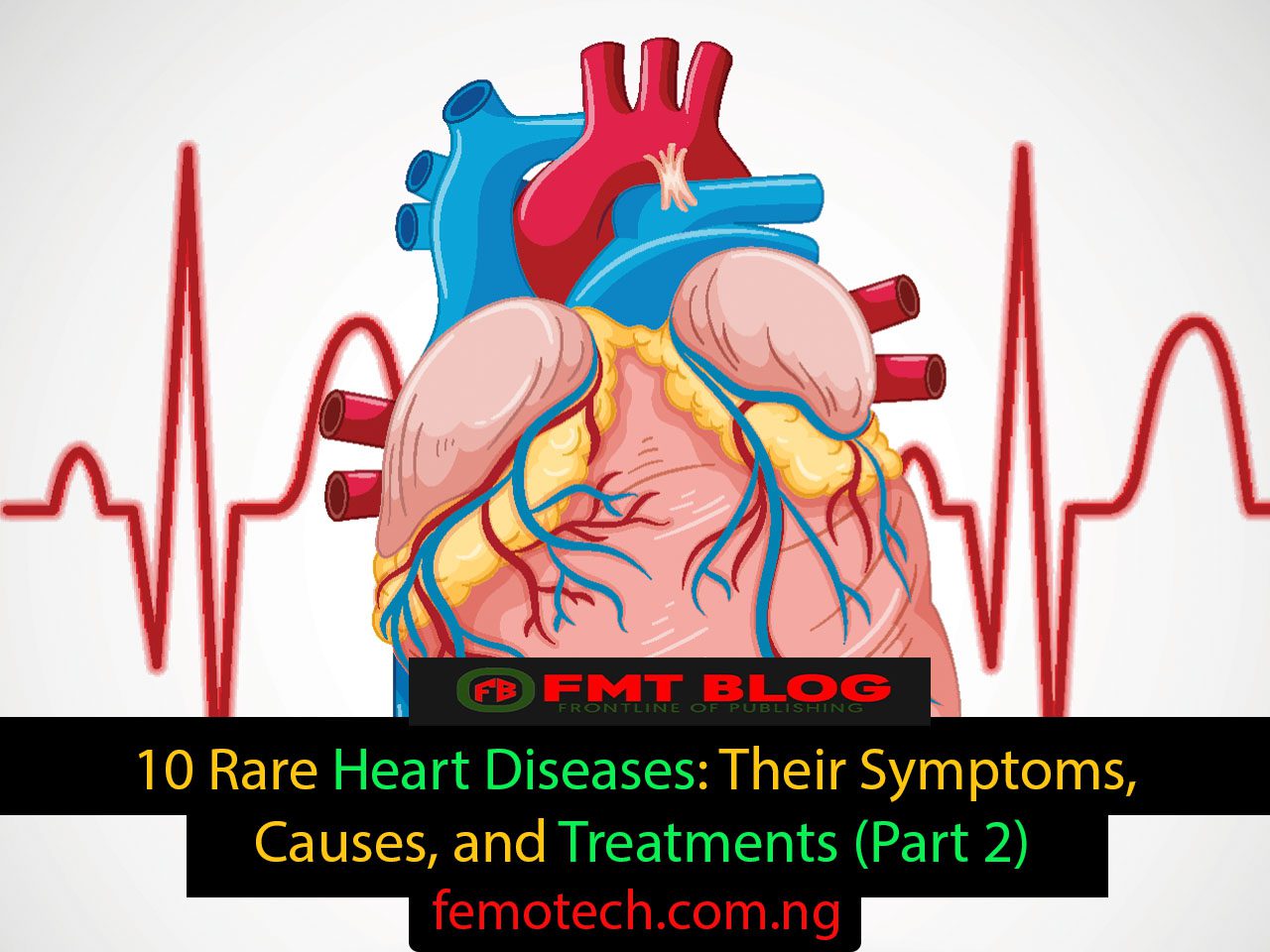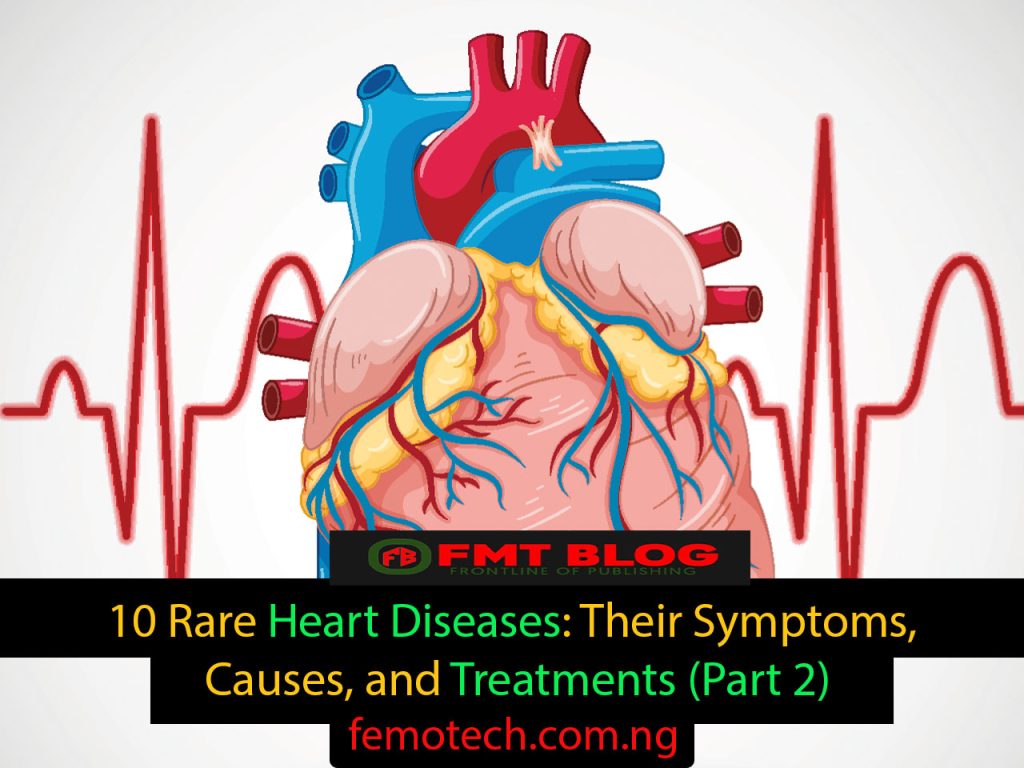
Learn about the top 10 rare heart diseases, including their causes, symptoms, and therapies. Discover how to recognize and treat these 10 rare heart diseases.

Introduction
In the first part of this article, we explored five rare heart diseases, delving into their characteristics, causes, symptoms, and potential treatment options. While these conditions may be less frequent than their more prevalent counterparts, they still pose significant challenges and require awareness from both individuals and healthcare professionals. This second part of the article delves deeper into the world of rare heart disease, exploring five additional conditions and their unique presentations.
If you haven’t already, be sure to check out the first part of this article, which explores the characteristics, causes, symptoms, and potential treatments of the first 5 rare heart diseases: For the first 5 rare heart diseases, click here. Then, come back here to learn more about another 5 rare heart diseases!
6. Long QT Syndrome (LQTS):
Long QT syndrome (LQTS) is a rare heart diseases characterized by a prolonged QT interval on an electrocardiogram (ECG). The QT interval, representing the time for heart muscle contraction and relaxation, is extended in individuals with LQTS, increasing the risk of life-threatening irregular heartbeats called torsades de pointes. Prompt diagnosis through tests like an ECG, genetic testing, and family history evaluation is crucial.
Symptoms of Long QT Syndrome:
- Fainting (syncope), especially during exertion or emotional stress
- Palpitations (feeling like your heart is racing, fluttering, or skipping beats)
- Dizziness or lightheadedness
- Seizures (in some cases)
Causes of Long QT Syndrome:
LQTS can be inherited (genetic) or acquired. Inherited LQTS is caused by mutations in genes responsible for heart rhythm regulation. Acquired LQTS can be triggered by certain medications, electrolyte imbalances, or other medical conditions.
Diagnosis and Treatment Options for Long QT Syndrome:
The diagnosis involves a combination of tests like an ECG, genetic testing, and family history evaluation. Treatment options include medications (mainly beta-blockers), lifestyle modifications, and implantable cardioverter-defibrillator (ICD) placement.
Is Long QT Syndrome life-threatening?
While LQTS can be life-threatening, especially if left undiagnosed and untreated, proper management with medications, lifestyle modifications, and potentially an ICD can significantly reduce the risk of complications and improve overall outcomes.
7. Hypertrophic Nonobstructive Cardiomyopathy (HNCM)
Hypertrophic nonobstructive cardiomyopathy (HNCM) is a rare heart disease characterized by thickening of the heart muscle without significant blood flow obstruction. This distinction influences symptoms and treatment approaches.
Symptoms of Hypertrophic Nonobstructive Cardiomyopathy:
- Shortness of breath, especially during exertion
- Chest pain
- Fatigue
- Palpitations (irregular heartbeats)
- Dizziness or lightheadedness
Causes of Hypertrophic Nonobstructive Cardiomyopathy:
HNCM, one of the 10 rare heart diseases, is primarily a genetic condition caused by mutations in genes responsible for heart muscle proteins. Diagnosis involves tests like the ECG, echocardiogram, and genetic testing.
Diagnosis and Treatment Options for Hypertrophic Nonobstructive Cardiomyopathy:
Treatment options include medications (beta-blockers, calcium channel blockers), lifestyle modifications, and, in some cases, pacemakers or implantable cardioverter-defibrillators (ICDs).
How is HNCM different from HCM?
While both HCM and HNCM involve heart muscle thickening, the key distinction lies in the degree of blood flow obstruction. In HCM, the thickened muscle can significantly obstruct blood flow out of the ventricles, leading to more severe symptoms and requiring a more aggressive treatment approach compared to HNCM.
8. May-Thurner Syndrome (MTS):
May-Thurner syndrome (MTS) is a rare vascular condition affecting the iliac veins, causing compression by the left iliac artery and leading to impaired blood flow in the right leg.
Symptoms of May-Thurner Syndrome:
- Chronic pain, swelling, and heaviness in the affected leg (usually the right)
- Discoloration of the skin in the affected leg
- Varicose veins
- Feeling of warmth in the affected leg
- Pelvic congestion syndrome (pelvic pain, cramping, and other symptoms) in women
Causes of May-Thurner Syndrome:
The exact cause of MTS is not fully understood, but factors like anatomical variations and external compression may contribute.
Diagnosis and Treatment Options for May-Thurner Syndrome:
Diagnosis involves tests like ultrasound, venography, a CT scan, or an MRI scan. Treatment options include endovascular stenting, balloon angioplasty, thrombolysis, and lifestyle modifications.
Who is most at risk for May-Thurner Syndrome?
While MTS can affect anyone, certain individuals may be at higher risk, such as women, people with a history of blood clots, and athletes.
9. Coronary Artery Fistula (CAF):
Coronary artery fistula (CAF) is a rare vascular anomaly where an abnormal connection exists between a coronary artery and another blood vessel, potentially leading to various complications.
Symptoms of Coronary Artery Fistula:
- May not cause any noticeable symptoms.
- Heart failure
- Chest pain
- Palpitations
Causes of Coronary Artery Fistula:
Congenital and acquired factors contribute to CAF. Diagnosis involves imaging tests like coronary angiography and echocardiograms.
Diagnosis and Treatment Options for Coronary Artery Fistula:
Treatment options include catheterization procedures (coil embolization, balloon occlusion) and open-heart surgery. Complications may include heart failure, endocarditis, and the steal phenomenon.
Can Coronary Artery Fistula cause complications?
While not everyone with CAF experiences complications, potential risks include heart failure, endocarditis, and the steal phenomenon.
10. Primary Pulmonary Hypertension (PPH):
Primary pulmonary hypertension (PPH) is one of the complex and rare heart diseases characterized by high blood pressure in the pulmonary arteries, leading to right-sided heart failure and various complications.
Symptoms of Primary Pulmonary Hypertension:
- Shortness of breath, especially during exertion
- Fatigue
- Chest pain or tightness
- Rapid heart rate (tachycardia)
- Swelling in the ankles and feet (edema)
- Dizziness or lightheadedness
- Bluish skin color (cyanosis) in severe cases
Causes of Primary Pulmonary Hypertension:
The exact cause is unknown in most cases, with factors like genetic factors, autoimmune diseases, congenital heart defects, and exposure to certain toxins or medications playing a role.
Diagnosis and Treatment Options for Primary Pulmonary Hypertension:
Diagnosis involves a comprehensive evaluation, including medical history, physical examination, chest X-ray, ECG, echocardiogram, right heart catheterization, and lung function tests. Treatment aims to manage symptoms and may include medications, oxygen therapy, surgery, or lung transplantation.
What is the outlook for someone with PPH?
The prognosis for individuals with PPH varies, with early diagnosis and proper management significantly improving the quality of life and life expectancy.
Follow us on socials → Telegram | X/Twitter | Facebook | WhatsApp |WhatsApp Channel |Mobile App
Conclusion:
In conclusion, this blog post has provided a detailed exploration of 10 rare heart diseases, emphasizing the importance of awareness and specialized care. Early detection and seeking medical attention are crucial for managing any heart condition, including rare ones. If you have concerns about your heart health or experience the symptoms mentioned, consult a healthcare professional for proper diagnosis and guidance.



